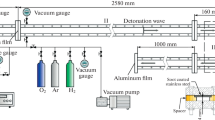Abstract
Below a threshold in overdrive, both stability analysis and numerical simulations predict that one-dimensional detonations in high activation energy mixtures behave as a chaotic sequence of failures followed by reignition. Instead, less chaotic, cellular detonations almost invariably occur in experiments. Numerical simulation, based on the Euler equations with single step chemistry, shows that a ZND detonation initially fails in that regime. The detonation splits into a weaker shock, a surface discontinuity separating reacted from unreacted fluid, and a rarefaction wave. However, the detonation is eventually reignited by the explosion of a small gas pocket, in a process reminiscent of deflagration to detonation transition. In the fluid heated by the leading shock, the chemical reaction occurs slowly at first, but becomes faster as heat is released, until the pocket explodes. Small differences in initial temperature result in large enough differences in reaction time sufficient for one pocket of fluid to explode. In two dimensions, the explosion occurs earlier because an oblique shock structure develops which unevenly heats the fluid that passes through the leading shock. Hence, pockets that underwent more heating will explode sooner. As it moves upstream, the two-dimensional explosion, meets the leading shock and the detonation quickly develops a transverse wave structure.
Similar content being viewed by others
References
Abouseif GE, Toong TY (1982) Theory of Unstable Detonations. Comb. Flame. 45: 67–94.
Boris JP, Landsberg AM, Oran ES, Gardner JH (1992) LCPFCT—A Flux-Corrected Transport Algorithm for Solving Generalized Continuity Equations. NRL Memorandum Report. Naval Research Laboratory, Washington D.C.
Boris JP, Book DL (1973) Flux-Corrected Transport. I. SHASTA, A Fluid Transport Algorithm That Works. J. Comput. Phys. 11: 38–69.
Bourlioux A, Majda AJ (1995) Theoretical and Numerical Structure of Unstable Detonations. Phil. Trans. R. Soc. Lond. A 350: 29–68.
Bourlioux A, Majda AJ, Roytburd V (1991) Theoretical and Numerical Structure for Unstable One-Dimensional Detonations. SIAM J. Appl. Math. 51: 303–343.
Buckmaster J (1988) Pressure Transients and the Genisis, of Transverse Shocks in Unstable Detonations. Combust. Sci. and Tech. 61: 1–20.
Edwards DH, Thomas GO, Nettleton MA (1979) The Diffraction of a Planar Detonation Wave at an Abrupt Area Change. J. Fluid Mech. 95: 79–96.
Erpenbeck JJ (1964) Stability of Idealized One-Reaction Detonations. Phys. Fluids 7: 684–696.
Erpenbeck JJ (1962) Stability of Steady-State Equilibrium Detonations. Phys. Fluids 5: 604–614.
Fickett W, Davis WC (1979) Detonation. Berkeley: University of California Press.
Fickett W, Wood WW (1966) Flow Calculations for Pulsating One-Dimensional Detonations. Phys. Fluids 9: 903–914.
He L, Lee JHS (1995) The Dynamical Limit of One-Dimensional Detonations. Phys. Fluids 7: 1151–1158.
Jones DA, Sichel M, Oran ES (1995) Reignition of Detonations by Reflected Shocks. Shock Waves 5: 47–57.
Kailasanath K, Oran ES, Boris JP Young TR (1985) Determination of Detonation Cell Size and the Role of Transverse Waves in Two-Dimensional Detonations. Combust. Flame 61: 199–209.
Knystautas R, Lee JHS, Guirao C (1982) The Critical Tube Diameter for Detonation Failure in Hydrocarbon-Air Mixtures. Combust. Flame 48: 63–83.
Lee HI, Stewart DS (1990) Calculation of Linear Detonation Instablitity: One-Dimensional Instablility of Plane Detonations. J. Fluid Mech. 216: 103–132.
Lee JHS, Moen IO (1980) The Mechanism of Transition from Deflagration to Detonation in Vapor Cloud Explosions. Prog. Ener. Combust. Sci. 6: 359–389
Lefebvre MH, Oran ES, Kailasanath K, van Tiggelen PJ (1993) The Influence of the Heat Capacity and Diluent on Detonation Structure. Combust. Flame 95: 206–218.
Lehr HF (1972) Experiments on Shock-Induced Combustion. Acta Astronautica 17: 589–587.
Meyer JW, Urtiew PA, Oppenheim AK (1970) On the Inadequacy of Gas Dynamic Processes for Triggering Transition to Detonation. Combust. Flame. 14: 13–20.
Moen IO, Funk JW, Ward SA, Rude GM, Thibault PA (1985) Detonation Length Scales for Fuel-Air Explosives. Prog. Aeronaut. Astronautics 94: 55–79.
Oppenheim AK, Soloukhin RI (1973) Experiments in Gasdynamics of Explosions. Annu. Rev. Fluid Mech. 5: 31–58.
Oran ES, Jones DA, Sichel M (1992) Numerical Simulations of Detonation Transmission. Proc. Roy. Soc. Lond. A 436: 267–297.
Oran ES, Boris JP (1987) Numerical Simulation of Reactive Flow. New York: Elsevier.
Oran ES, Young TR, Boris JP, Picone JM, Edwards DH (1982) A Study of Detonation Structure: The Formation of Unreacted Gas Pockets. In Proceedings of the Nineteenth Symposium (International) on Combustion, pp. 573–582. Pittsburgh: The Combustion Institute.
Quirk JJ (1994) Godunov-Type Schemes Applied to Detonation Flows. Combustion in High-Speed Flows. (J. Buckmaster et al. eds.), pp. 575–596.
Saint-Cloud JP, Guerraud CI, Brochet C, Manson N (1972) Some Properties of Very Unstable Detonations in Gaseous Mixtures. Acta Astronautica 17: 487–498.
Strehlow RA (1984) Combustion Fundamentals. New York: McGraw-Hill.
Taki S, Fujiwara T (1981) Numerical Simulation of Triple Shock Behavior of Gaseous Detonations. In Proceedings of the Eighteenth Symposium (International) on Combustion, pp. 1641–1649. Pittburgh: The Combustion Institute.
Taylor G (1950) The Dynamics of the Combustion Products Behind Plane and Spherical Detonation Fronts in Explosives. Proc. Roy. Soc. Lond. A 200: 235–247.
Thibault PA, Zhang F, Penrose J, Sulmistras A (1994) Numerical Modeling of Detonation Driven Hollow Projectiles. In: Proceedings of the Second Annual Conference of the CFD Society of Canada, pp. 395–402. Toronto: University of Toronto.
Urtiew PA, Oppenheim AK (1966) Experimental Observations of the Transition to Detonation in an Explosive Gas. Proc. Roy. Soc. Lond. A 295: 13–28.
Weber JW, Anderson JD, Oran ES, Patnaik G, Whaley R (1995) Load Balancing and Performance Issues for the Data Parallel Simulation of Stiff Chemical Nonequilibrium Flows. AIAA Paper 95-0579. 33rd AIAA Aerospace Sciences Meeting and Exhibit, Jan 9–12, Reno, NV.
Author information
Authors and Affiliations
Corresponding author
Rights and permissions
About this article
Cite this article
Williams, D.N., Bauwens, L. & Oran, E.S. A numerical study of the mechanisms of self-reignition in low-overdrive detonations. Shock Waves 6, 93–110 (1996). https://doi.org/10.1007/BF02515193
Received:
Accepted:
Issue Date:
DOI: https://doi.org/10.1007/BF02515193




